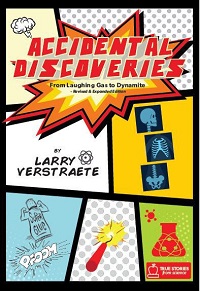| ________________
CM . . .
. Volume XXIII Number . . . .February 17, 2017
excerpt:
Inspiration, motivation and determination: these words describe the qualities necessary for the creation of many of the inventions that changed the world. In this newly revised and expanded edition, Verstraete engages and entertains readers with over 80 stories of flukes, errors, twists of fate, unexpected discoveries and serendipitous and “Aha!” moments which led to amazing breakthroughs in a variety of disciplines, from medicine and astronomy to agriculture and fashion. The book is divided into six chapters, each of which contains information about the inventors/discoverers and the history behind their inventions, innovations and discoveries which date from 540 BC to the late 1900s. Verstraete’s conversational writing style and his use of anecdotes draw the reader in and add a personal touch, making the inventors seem more “human” and not just “mad scientists” working in a lab. There are stories of perseverance, such as that of Charles Goodyear, who struggled for 10 years to perfect the formula for vulcanized rubber; stories of great wealth, such as Elias Howe, inventor of the sewing machine, who had amassed a fortune of $13 million when he died in 1872 (a huge amount of money for that time); and stories of people who were disgraced and ridiculed, an example being Dr. Ignaz Semmelweis, who was shunned by his peers when he suggested that doctors needed to wash their hands between patients to avoid the spread of deadly germs. Sometimes the invention was named after its inventor (e.g. Kellogg’s Corn Flakes, McIntosh apples), but occasionally, the invention was named after a family member (James Hargreaves’ spinning Jenny was named after his daughter, while James Christy’s discovery of one of Pluto’s moons- Charon- was named for his wife Charlene). Some of the featured inventions include denim jeans, safety glasses, microwave ovens, x-rays, stethoscopes, Teflon, Lifesavers candy, potato chips, popsicles, shopping carts, Slinky toys, jigsaw puzzles, Super Soakers, Velcro, nylon, Ivory soap, Post-It notes and ink-jet printers. One minor flaw in Accidental Discoveries is that almost all of the stories are about male inventors. There are a few exceptions: chemist Stephanie Klowek, who created Kevlar, used in the making of bulletproof vests; zoologist Katherine Payne, who proved that elephants communicate with each other by making hundreds of calls, many of which are too low in frequency to be heard by humans; Patsy Sherman, who invented Scotchgard; and 12-year-old Mary Anning who, in 1812, discovered the skull of an ichthyosaur in the limestone cliffs while playing on a rocky English beach. Perhaps Verstraete could have included more stories about female inventors, for instance, Bette Naismith Graham who invented Liquid Paper, or Mary Anderson, who invented windshield wipers. Sparing use of ink line sketches is effective because the stories are so engaging that there really is no need for a plethora of illustrations. A table of contents, a glossary, an index and a list of books for further reading are provided. Celebrating the curiosity, creativity and persistence (and even the quirkiness) of the many inventors/discoverers featured, and, perhaps, inspiring budding scientists to follow their passion, Accidental Discoveries From Laughing Gas to Dynamite is a fun, amusing and enjoyable read. Recommended. Gail Hamilton is a former teacher-librarian in Winnipeg, MB.
To comment
on this title or this review, send mail to cm@umanitoba.ca.
Copyright © the Manitoba Library Association. Reproduction for personal
use is permitted only if this copyright notice is maintained. Any
other reproduction is prohibited without permission.
Next Review | Table of Contents For This Issue - February 17, 2017 |
